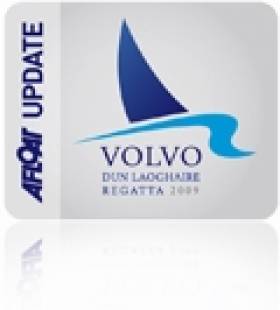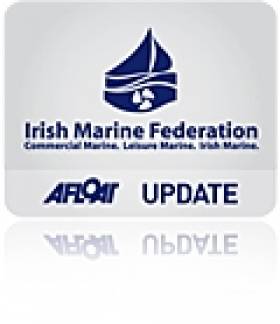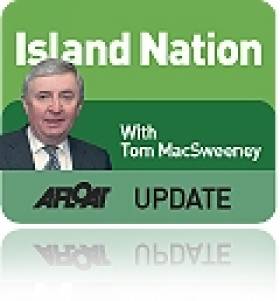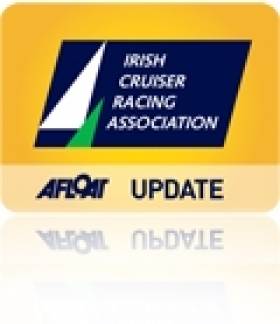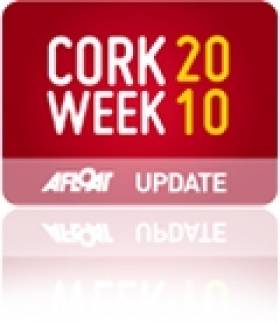Displaying items by tag: Irish
Irish Sea Events Offer Entry Discounts
"The way this works is that the Clyde Cruising Club are offering a 25% rebate for boats from the 4 Dun Laoghaire Clubs (DMYC, NYC, RIYC, RStGYC) that enter the Brewin Dolphin Scottish series before the expiration of the early bird discount period which expires on April 22nd explained Dun Laoghaire event secretary, Ciara Dowling.
As a reciprocal arrangement the committee of the Volvo Dun Laoghaire Regatta are offering a discount of 50% from the full entry fee to all boats that enter both regattas. To avail of this, boats must register for the early bird entry fee in the Volvo Dun Laoghaire Regatta prior to 2 May 2011. Note the 50% discount will be applied to the full entry fee rate and not the early bird rate.
To avail of this arrangement for the Scottish Series contact the Brewin Dolphin Scottish Series office for details, [email protected] 0044141 221 2774.
To avail of this arrangement for the Volvo Dun Laoghaire regatta visit the event website at www.dlregatta.org or email [email protected]
The Scottish Series takes place from 27–30 May and the Dun Laoghaire regatta from July 7th–10th 2011.
In a further boost for Dun Laoghaire sailors heading north the feeder race from Bangor to Tarbert has been re-instated.
Troon and Largs Marinas are offering competitors berthing rate discounts around Scottish Series.
Competitors from Scotland coming to Dun Laoghaire are reminded that the entry fee to the regatta includes free berthing for the duration of the event.
The official Notice of Race and Online Entry are now available at www.dlregatta.org
2011 Irish Coast Sailing Directions Published
The Irish Cruising Club's acclaimed Sailing Directions, in two volumes, offer comprehensive coverage of the entire coast of Ireland, and their price has recently been reduced by £10.00 to £27.50 each (€32.50).
These are the only cruising guides for the Irish coast to be frequently and comprehensively updated, with corrections available free at www.irishcruisingclub.com.
The 310 page South and West volume was reviewed in Cruising magazine, Sept 2010: "If you are intending to cruise these coasts, or even if you are only thinking of doing so, it is essential. As Sailing Directions they are well-nigh perfect."
Written, edited, designed and printed on the island of Ireland, these handsome hardback books are carried as an aid to navigation and pilotage by the Irish Naval Service, the Irish Coast Guard and the Commissioners of Irish Lights, and they are used as a reference source by the UK Hydrographic Office.
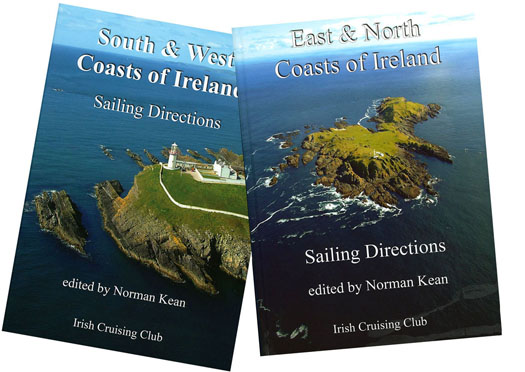
ICC SDs are available from chandlers and booksellers, and are distributed in Great Britain and the rest of the world by Imray, and in Ireland by Todd Chart Services. East and North Coasts Directions ISBN 978 0 9558 199 1 9; South and West Coasts Directions ISBN 978 0 9558 199 2 6.
Sailing Body Elects First Female President
In one of her last official functions as Minister for Sport, outgoing local TD Mary Hanafin attended the Irish Sailing Association's annual Ball last Saturday in the Royal Marine Hotel in Dun Laoghaire.
Attended by 315 people the black tie ball featured an awards ceremony that has been hailed 'a great success' by the association.
On Saturday afternoon the association elected a new President, Niamh McCutcheon, the first female ISA President since the organisation was founded in 1945.
A collection in aid of the RNLI raised over €2,250.
Award details below:
ISA Sailing Achievement of the Year
This award is presented by the ISA to recognise the outstanding achievement in a sailing craft by an Irish person or in Ireland during 2010.
Winner: Nicholas 'Nin' O'Leary, Royal Cork Yacht Club
Nicholas' achievements included narrowly beating his father Anthony at the ISA All Ireland Championships in 2010 by just a single point after a nail-biting finale in difficult conditions off Kinsale in November. The win made it three-in-a-row for this remarkable young 24 year old sailor - the only person to achieve this in the 64 years of the event's history.
ISA Volunteer of the Year
This award is given to a member of an ISA affiliated club or class who has made a significant voluntary contribution to their sport during 2010.
Winner: Brian Craig, Royal St. George Yacht Club.
Brian has been nominated by the Royal St. George Yacht Club for the vital role he has played in developing sailing in Ireland and specifically Dun Laoghaire over the past 40 years. His most recent success was winning the bid for Dun Laoghaire to host the 2012 ISAF Youth Worlds.
ISA Youth Sailor of the Year
This award is presented by the ISA to recognise the outstanding achievement by a sailor competing in ISA Performance Pathway boats during 2010.
Winner: Finn Lynch, Blessington Sailing Club
Placing 2nd overall at the Topper World Championships in 2010 left the Carlow sailor in good stead for a Youth Sailor nomination. A determined sailor and strong character, it's clear that with these strengths Finn has the potential to go far in our sport.
ISA Instructor of the Year
This award recognises the role instructors have in providing access to our sports. The final 5 have been nominated by their students with the ultimate winner selected by an ISA judging panel.
Winner: Aine Carroll, Rush Sailing Club
Aine has been an ISA instructor for the last 11 years, instructing both adult and junior sailors in Rush Sailing Club. A keen Mermaid sailor, her love of sailing, her enthusiasm for the sport and willingness to give her time to her sailors have been infectious and remarkable. Apparently the kids at the club think she is a 'legend' and 'cool'!
ISA Training Centre of the Year
The face of ISA water sports to thousands of participants. The best in 2010 as nominated by their students.
Winner: University of Limerick Activity Centre
Situated on the sheltered shores of Lough Derg, University of Limerick Activity Centre has been in operation for over a decade. ULAC provides a varied programme of adventure activities to the general public. The University of Limerick Activity Centre runs ISA courses in sailing dinghies, windsurfers, powerboat as well as emergency care training courses.
Conference Reveals State of Marine Leisure Industry
With boat sales falling by as much as 80%, marina business down 20%, retail sales in chandlery down up to 38%, insurance down 12.5% the marine industry in Ireland and Wales had to take some action to ensure the marine trade and leisure industry survives.
An unusual industry conference took place in Dun Laoghaire today and yesterday with the objective of understanding where the industry is right now and how it needs to act to ensure that it survives the downturn in our economies.
Over 125 marine businesses from both sides of the Irish Sea will be attending in what will be the largest marine leisure Industry gathering ever brought together.
A joint address was given by the Executive Director of the British Marine Federation, Howard Pridding and David O'Brien the Chairman of the Irish Marine Federation set the scene as to where the industry is on both sides of the Irish Sea.
The conference heard from 3 companies who operate in the sector. One from each region, North Wales, South Wales and Ireland who will share with the conference their experiences in the current economic climate on how they are surviving and thriving in the downturn. Business tactics that need to be deployed were explored with a leading business and innovation specialist from Wales together with joint talks by Visit Wales and Failte Ireland on the development of marine leisure tourism.
Leading economist Jim Power delivered a talk on the economic situation and when we might begin to see some consumer confidence return to our markets.
The Pembroke Coastal Forum told how they have managed their coastline and environment and how they have facilitated marine leisure tourism through proper marine spatial planning.
The conference is being organised by irish-sea.org and Ireland/Wales Interreg IV A Programme funded by the European Region Development Fund.
Irish-sea.org has three partners, North Wales Watersports, South West Wales Marine Federation and the Irish Marine Federation.
Marine Leisure Conference Aims to Combat Downturn
Over 120 marine trade and leisure companies from Ireland and Wales are coming together in Dun Laoghaire this week to examine ways to combat the current economic downturn on both sides of the Irish Sea.
Speakers at the conference at the Royal Marine Hotel are drawn from Industry representative organisations, tourism bodies, marine leisure companies, business development specialists, economists and irish-sea.org will provide insights and share knowledge on how to survive the downturn and emerge leaner and stronger when the recovery arrives.
The conference will also provide an industry wide networking opportunity for companies from Ireland and Wales to share experiences and develop business links across the Irish Sea.
Irish-sea.org is an Ireland/Wales Interreg IVA Programme to develop the Irish Sea into a marine leisure centre of excellence.
The programme provides help and support to the sector on both sides of the Irish Sea through marketing, business and vocational training and assisting in the acquisition of research data.
Rejig Means No South Coast Match Racing Fixtures
There will be no match racing on the south coast this year following a rejig of the fixtures calendar.
After two years of expansion for match racing in terms of events the theme for 2011 is consolidation.
Changes to the ISA SailFleet schedule for the boats mean that we have had to go through a rejigging of the match racing calendar.
The major impact is that Royal Cork YC are to take the boats latter than originally hoped meaning that they will be unable to host a leg of the Tour.
With Kinsale not taking part in the SailFleet scheme this year that means no match racing on the south coast for the first time in a couple of years.
With no tie up with the Dun Laoghaire Festival of Cultures available this year a date of July 23rd and 24th has been settled on for the Ireland vs The World International.
The highlight of last year this event will once again pit Irelands 6 best match racers against 6 teams from the rest of the world. Once again National and Tour champion John Sheehy will captain the Irish team.
The Leinster Match Racing Open, to be hosted by the Royal Irish Yacht Club, has been moved to July 16th and 17th to allow it to act as qualification for the Irish team for the following weekend and to give Laura Dillion and the Gladiators (Sam Hunt, Paddy Blackley, Peter Bayly, Richard Murphy) competitive practice immediately before heading over to Poland to represent the country at the ISAF Nations Cup.
Howth Yacht Club's, Dublin Match Racing Open stays with a date of September 3rd and 4th before we head for Lough Derg and the Womens (October 15th and 16th) and Open National Championships (November 5th And 6th).
All of the above means that here will be no Munster Match Racing Open this year and work continues to find a host for the IUSA Student Match Racing Nationals with Galway a potential for early April. There has been considerable work on the cost of entry for events over the winter and the majority of events will have a basic entry of €330 this year. All events will be run at ISAF grade 3.
Revised calendar
July 16-17th – Leinster Match Racing Open, Royal Irish Yacht Club
July 23-24th – Ireland vs The World International, Royal St George Yacht Club
September 3rd and 4th – Dublin Match Racing Open, Howth Yacht Club
October 15th and 16th - Womens Match Racing Championships, Lough Derg Yacht Club
November 5th and 6th – National Match Racing Championships, Lough Derg Yacht Club
An Irish Maritime Foundation
I wonder whether there might be interest in forming an Irish Maritime Foundation?
I raise the question having discussed the possibility with those who run the UK Maritime Foundation and whose views about the sea about the sea impressed me when I met them in London. The Foundation traces its history back to 1981 when shipowners, senior retired naval officers and people involved in the financial industry reacted to changes in British Government policy that were regarded as failing to protect the importance of the UK maritime industry. It is a registered charity with the purpose of promoting and raising interest in the maritime sector amongst the public, the media and Parliament. To do so it is involved in assisting development of maritime education, training and research.
The British are a magnanimous people in my view. It was an honour to accept the Desmond Wettern Award from the Foundation. Desmond Wettern was a distinguished UK maritime journalist for over 30 years and the awards were established in his name. This year the Society for Nautical Research joined the awards project.
In responding I used one of my favourite descriptions - "the Family of the Sea," which I have used on radio. It drew a lot of interest from those present. I believe there is a "family of the sea" which spans oceans and seas, linking those who appreciate the sea as essential to human survival.
"Everyone who has an interest in the sea would recognise that there are and will continue to be, increasing pressures on its use and on the exploitation of its finite resources, but also a number of opportunities," according to Rear Admiral Christopher Perry, Chairman of the UK Marine Management Organisation. Those views and others I discussed with some of those amongst the 200 attending the function, who came from various parts of the world. Professor Richard Harding of the Society for Nautical Research which is marking its centenary, expressed this opinion: "There is a disturbing sense of sea-blindness in the British Government, amongst the general public at large and in the media."
There is certainly sea-blindness in our Government and in much of the media, though I am hopeful that there is growing awareness of the importance of the marine sector amongst the general public. If Ireland had an organisation like the Maritime Foundation, I would be very pleased.
• This article is reprinted by permission of the EVENING ECHO newspaper, Cork, where Tom MacSweeney writes maritime columns twice weekly. Evening Echo website: www.eecho.ie
New Trailerable 30 Footer to be Unveiled at ICRA Conference
Commodore Barry Rose is urging Cruiser Racers fans to support this weekend's eighth annual ICRA conference at the Carrigaline Court hotel in Carragaline, County Cork.
There's a big line up for the one day event that includes a presentation on an innovative concept to develop a 30 Footer one design concept that can also sail under IRC handicap. The idea is that it will be trailerable to attend ICRA Nationals and other events around Ireland. Rory Staunton travels from the UK to make the 30 footer presentation.
Rose says Saturday's event gives an opportunity to exchange 'constructive opinions to promote and develop the cruiser/racing', the biggest sector of Irish Sailing.
The event includes a celebration dinner for the Commodores Cup team at the Royal Cork Yacht Club.
Designers John Corby and Mark Mills will be present to update us on IRC developments and boat design and their thoughts on where boat design is heading. More HERE
Cork Week: Cork Revealed, with Eddie English
Cork Week Revealed
with Eddie English (reprinted from Afloat 2006)

Eddie English stands high on Cobh’s historic waterfront and looks out across Cork Harbour, south towards Roche’s Point lighthouse and the entrance to the natural sailing sanctuary. Immediately below, a huge Brittany Ferries ship heads slowly out to sea; it’s not even close in size to a previous visitor to the former Queenstown, but then again, the RMS Titanic belonged to a different era.
To his left, the inshore waters north of the Whitegate oil refinery hide the channel to East Ferry where the Marlogue Inn stands over its marina and just opposite, the legendary Murphs on the mainland shore.
On his right, the channel between Spike and Haulbowline Islands and Cobh is the main shipping route for the Port of Cork for ferries, commercial shipping and the Irish Naval Service base.
But it’s the view straight out to sea that confirms one of the magic ingredients that have made Cork Week an international regatta of worldwide repute: vast tracts of open, unobstructed water and all within easy reach of the shoreside facilities of the hosts at the Royal Cork Marina at Crosshaven.
When it comes to local knowledge, few are as expert as English. Not only is he a former chairman of the event's racing committee, not only does he run a long-established sailing school in the harbour, but when you are offered an insight from someone who takes his dog for a walk on notorious mud banks at low water springs, they tend to be nuggets of the golden variety.
"The harbour course is the key to Cork Week," says English. "It's the decider where the event is won or lost and has the most variables involved." So this, then, is the Eddie English step-by-step guide to gaining an edge for that course, plus the coastal, wind/leeward and Olympic-type courses at Cork Week.
COPYRIGHT – AFLOAT MAGAZINE 2006
Cork Week and How You Can Win
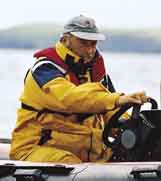 How you can win at Cork Week
How you can win at Cork Week
with more than a little help from local expert Eddie English [pictured left] – Cork Week 2004 (reprinted from Afloat July 2004). For all the up to date information and news on Cork Week click here.
Eddie English stands high on Cobh’s historic waterfront and looks out across Cork Harbour, south towards Roche’s Point Lighthouse and the entrance to the natural sanctuary. Immediately below, a huge Brittany Ferries ship heads slowly out to sea; it’s not even close in size to a previous visitor to the former Queenstown, but then again, the RMS Titanic belonged to a different era.
To his left, the inshore waters north of the Whitegate oil refinery hide the channel to East Ferry where the Marlogue Inn stands over its marina and just opposite, the legendary Murphs on the mainland shore.
On his right, the channel between Spike and Haulbowline Islands and Cobh is the main shipping route for the Port of Cork for ferries, commercial shipping and the Irish Naval Service base.
But it’s the view straight out to sea that confirms one of the magic ingredients that have made Cork Week an international regatta of worldwide repute: vast tracts of open, unobstructed water and all within easy reach of the shoreside facilities of the hosts at the Royal Cork Marina at Crosshaven.
When it comes to local knowledge, few are as expert as English. Not only is he chairman of the event's racing committee, not only does he run a long-established sailing school in the harbour, but when you are offered an insight from someone who takes his dog for a walk on notorious mud banks at low water springs, they tend to be nuggets of the golden variety.
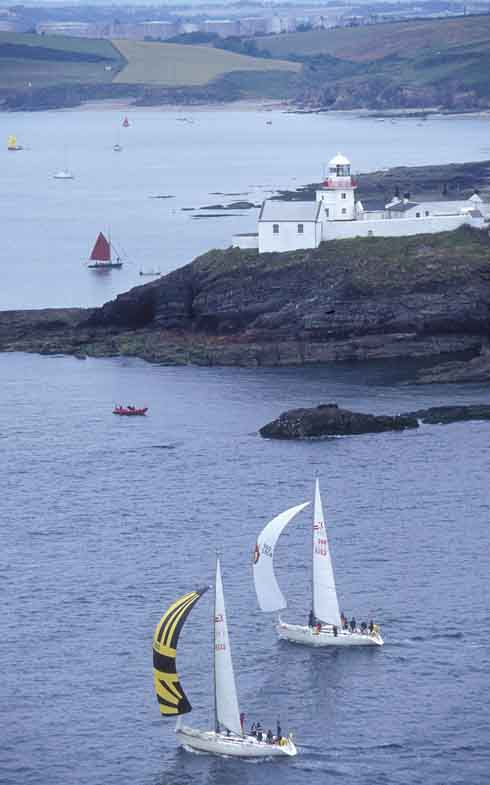
Left: Sigma 33s negotiate Roche’s Point
"The harbour course is the key to Cork Week," says English. "It's the decider where the event is won or lost and has the most variables involved." So this, then, is the Eddie English step-by-step guide to gaining an edge for that course, plus the coastal, wind/leeward and Olympic-type courses at Cork Week 2004.
Harbour Race
Above all, be conservative at the start of the Harbour Race if the tide is with you on the start off Weaver's Point. There can be two knots of tide here typically and an OCS in any fleet represents the end of the story with recovery improbable. Ideally, a short tour of the harbour during the weekend registration stage of Cork Week will pay dividends. If you can, borrow a RIB and take the tour at low-water.
Two marks form part of this course outside the harbour and rounding order will depend on wind-direction on the day. The first is off Ringabella to the south-west shore heading towards Kinsale. If there’s a flood tide, hug the shore. In fact, if the breeze is SW, go right, even in an ebb.
The second is off Trabolgan, east of Roche's Point. Crucially, beware of the strength of tide when traversing the channel across the harbour entrance. Don't just rely on the GPS – plot the tidal vectors to find the true course to steer. Once to the east of Roche's Point, there’s negligible tide and often a tide line can be observed.
This course then takes the fleet into the harbour but beware when entering on the east side of the Harbour mouth – the Cow and Calf rocks are extensions of Roche's Point up to one cable off the shore.
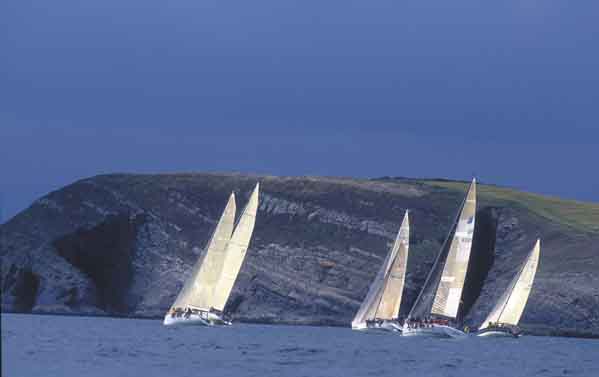
Above: Hugging the shoreline for a tactical advantage
Most races will come into a buoy east of Cobh, making this a long leg in, but offer plenty of hazards on a falling tide. After the Cow and Calf, it’s possible to dodge into White Bay but be wary of rocks and shallows on the south end of the bay close to Roche's Point.
The Dog's Nose promontory is next and it’s possible to cut into the area north of here though close inshore it shallows and the Black Rock is marked by a perch as the main hazard.
Bear in mind the sailing instructions that require clearance of 50 metres off the oil refinery jetty at all times. A listening watch on VHF Ch. 12 is useful for avoiding shipping.
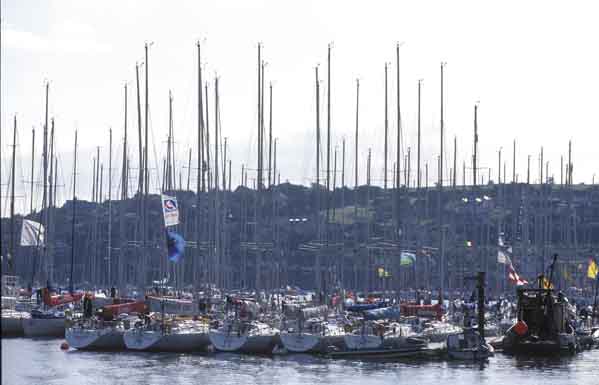
Above: The fleet at anchor – everyone’s gone to the pub...
Once past the refinery jetty, the tide running north-east/south-west for the East Ferry channel can suck you in or push you out.
The alternative to the eastern shore approach is to hug the western shore and involves rock-hopping from Ringabella in past Weaver's Point. An option is to duck into the Owenbue River at Crosshaven – the tide ebbs here up to 30–40 minutes before HW Cobh.
North of here, the Curlane Bank, south of Spike Island, offers an option but beware of shallows. The area south-east of Spike is littered with rocks and, in particular, off the eastern end is a large rock marked by a perch.
The Spit Bank is the biggest in the harbour and is located from the north end of Spike from the lighthouse to the corner off Haulbowline. On very low spring tides, football is played on this bank. The key here is: go as close as you dare. The bank is mostly mud except for ‘The Seven Stones’ aka The Ballast Rocks located approximately two cables east south-east of the No. 20 (Port) Buoy.
Having made the turn for the final approach to the Cobh rounding buoy, one of the showcase marks in the entire event set beneath the picturesque back-drop of the town, this leg from ‘Cuskinny Turn’ offers several options in tide. With the tide is a straight-forward matter of choosing the deepest water so check the charts. Usually, the north shore offers no significant gains. Keep a sharp watch for the passenger ferries running from Cobh to Spike and Haulbowline Islands.
From Cobh, the Harbour Race will have a new finishing line in 2004, moving to the No. 7 (starboard) buoy south of the refinery.
Coastal Course
Going west from the start in a south-westerly or filling sea-breeze, taking the right-handside of the course, pays off, thanks to lifts off the shore. Use the bays to get out of the tide, with the exception of the first bay after Robert's Head/Daunt buoy – it’s called Rocky Bay and it is!
The tide here follows a south-west/north-east direction in line with the heads with a one-knot maximum. Keep the harbour entrance strategy from the previous course notes in mind too.
For 2004, the former south-east mark located approximately three miles east of Roche's Point has been renamed Moonduster as a tribute to the late Denis Doyle and his legendary 51-foot yacht that is synonymous with Cork.
All Courses
The Olympic and windward/leeward are located outside the harbour so allow plenty of time to get afloat – some courses could take you up to an hour to reach as the number of yachts leaving Crosshaven at one time can mean congestion. The furthest course is three miles south-east of Roche's Point which in turn is two miles from Crosshaven. Don't assume the Race Officers will wait – best advice is to follow the professionals' example and leave early to be at sea on time with an opportunity to practice a few crew drills.
These courses usually have no significant tidal factors as most are located outside the harbour and beyond the main entrance tide line. More importantly, if a sea breeze builds, this will be of more use to you.
If a sea-breeze applies, it generally tends to build from around 11am, peaks at 3pm and is gone by 6pm. It will usually begin in the south/south-east provided the gradient doesn't block it. It tends to veer throughout the day until it comes from the SSW to SW – always moving right as the day progresses. Be vigilant to spot it building as it applies to all courses.




























